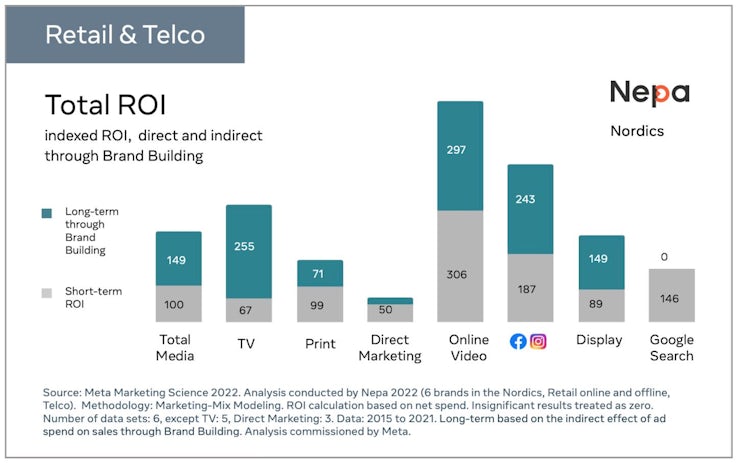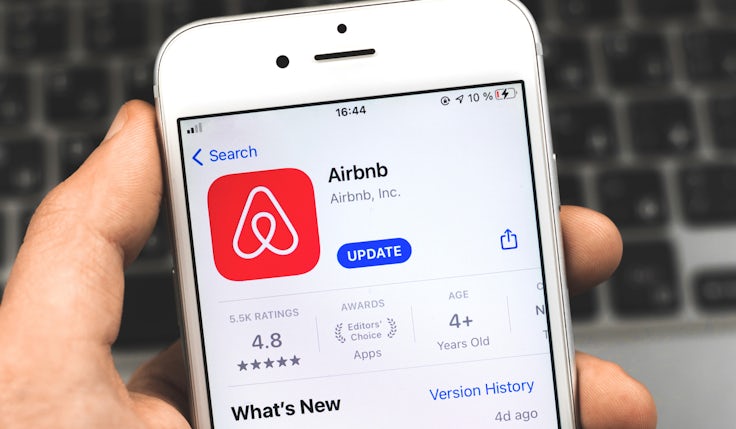Is your brand stuck on the performance plateau?
What is it, why are you stuck on it, how are you going to get off it?

It’s become common for brands with a performance mindset, to hit a growth plateau. Let’s call it the ‘performance plateau’. If you think you may have hit it, you’re far from alone. From the number of companies I’ve seen grappling with the issue in recent years (and long before talk of recession), it seems to be endemic in marketing today. And it’s not just SMEs and scaleups, even big names can be affected.
It’s a problem that seems to have its roots in the performance-oriented mindset of the millions of SMEs who make up the bulk of today’s advertisers, and the continuation of that mindset well past the point when their scale suggests they should have adopted a more balanced marketing approach.
TL;DR: what got you where you are now, won’t get you where you want to go.
What is it?
It’s about brands getting to a point where the success of their traditional mix of search, social and display advertising levels off, leaving them looking around for new ways to grow.
The story often goes a bit like this…
A brand’s initial growth has stalled. Customer acquisition costs are higher than ever, previously good return on ad spend (ROAS) has fallen. Everything’s become inefficient and more efficient ad buys are harder to come by. You’re not sure where new customers are going to come from. Everything you thought worked doesn’t seem to work so well any more. A previously direct link between advertising and growth seems to have been weakened. All the low-hanging fruit seems to have been picked.
Within the marketing team nervousness is setting in, and beyond it founders and investors are starting to question everything.
“We used to be able to put £1 in and get £1.70 back. That’s just not happening any more. At best we have to put £1.50 in for the same return but investors are starting to ask tough questions about where growth is going to come from,” an anonymous founder told me.
Performance-oriented brands can lack the skills, experience, people and partners needed to take them to the next level.
The performance plateau seems to be something you have to go through these days to make the transition to maturity as a marketing organisation. It’s like working through the gears on a bike: you’re no longer able to pedal faster in a lower gear so you’re going to need to invest more effort in higher gears to start accelerating.
Econometrician Dr Grace Kite’s work had been pointing to this as an issue for performance-driven brands, and the chart below, based on her econometric modelling for a wide range of digital-first brands, was created by us to capture this moment and describe the benefits that can come later once a more balanced approach is deployed.
 When presenting this chart we’ve both seen just how much the plateau resonates with marketers. On the chart it looks placid, but in reality it can feel existential.
When presenting this chart we’ve both seen just how much the plateau resonates with marketers. On the chart it looks placid, but in reality it can feel existential.
Who’s affected?
Over the last year I’ve spoken to around a dozen brands in this situation. Businesses of different sizes, both B2C and B2B. They include a weight loss app, a B2B data viz platform, a buy now, pay later payment brand, a major US D2C mattress brand, and a mobile gaming platform. At a conference for FMCG brands recently, who Grace and I were presenting to, when Grace asked if they’d experienced this, around 80% of people’s arms shot up. So if you’re experiencing it too you’re not alone.
And it’s not just small- and medium-sized brands who can find themselves on the performance plateau. Even huge brands who’ve taken some wrong turns can also find themselves on it.
Recently we’ve seen Airbnb and Asos admit to a chronic over-reliance on performance and a subsequent shift in balance towards brand-building activity as they look to put an era of sluggish growth behind them. Of course, this won’t have been the only cause of their problems, but it doesn’t invalidate the point.
I know from personal experience there were many people who tried to persuade Asos of the dangers of their approach. Many others will have similar cautionary tales from other businesses.
Asos CEO blames acquisition slowdown on ‘insufficient’ brand spend
Regardless of the economic environment right now, there’s definitely a common thread: a brand has success with performance marketing, doubles down on it, but later realises it wasn’t helping them achieve long-term growth, and belatedly course-corrects to a more balanced approach.
Why it happens
What happens is that the platforms are great at helping brands optimise their direct response advertising, but once spend is maxed out on them, brands are far from ready to make the transition to taking a more balanced ‘full-funnel’ approach.
Performance-oriented brands can lack the skills, experience, people and partners needed to take them to the next level. Essentially there’s friction in the system that creates massive delays in brands’ ability to recognise they have an issue, and get themselves geared up to kickstart their growth again.
Getting beyond the plateau
Every brand of course needs its own bespoke growth strategy. No article can tell you how to develop one, but it can point to what connects brands that have successfully navigated this moment.
It often includes developing a new philosophy about how marketing and advertising work to grow brands; a new growth model defining how it will work for your brand; new people and maybe new partners; new measurement and metrics.
That’s a lot of new stuff to learn and do, which may explain why the plateau can last a long time. So here are some key things for brands to think about as they plot their new path.
1. Unlearn what you know
The first major thing that connects the brands that get off the plateau is that they go through a period of introspection and analysis, unlearning and learning, about how brands grow and how marketing and communications work. This has to be something the whole team goes through together with a brand’s leadership: this will all be pointless if your leadership isn’t on the journey.
You won’t get off the performance plateau armed with spreadsheets alone.
This is probably the hardest step as it will involve challenging people’s existing views. There’s a considerable body of knowledge out there on this, built up over decades, that can help. Mark Ritson’s Mini MBA covers much of it. Here’s an article from the reading list on the topic of ‘bothism’ that seems to help brands at this point: The wrong and the short of it. And this is Grace Kite’s typically practical, real-world take on the topic.
Performance-oriented people can tend to be quite left-brained in their worldview. Theirs is a world where you put X in knowing you will get Y out. A world where everything can be tested and the correct answer is known instantly. But where you’re going things don’t quite work like that. You’ll need to get comfortable with a greater level of ambiguity, with irrational consumers, qualitative research, the huge variation of effects from different creative campaigns. Where you’re going you’ll need balance: of data and judgement, technology and creativity, art and science, long and short. You won’t get off the performance plateau armed with spreadsheets alone.
2. Know your (growth) audience
Digital-first brands, and D2C brands in particular, often believe they know their audiences inside out. But owning the data on what existing customers do on your digital real estate isn’t going to be enough. You’re going to need to really understand all category buyers, and especially non-users and very light users of your brand who are going to be disproportionately important to you now.
Get to know the people who couldn’t care less about you just as well as those who love you, and work out what you need to do to attract them. Chances are you’ll discover it’s got a lot to do with not being known by them, not being thought of in the right moments, your brand not being associated with the right things. Understanding your growth audience inside out is fundamental to your positioning, and will be essential to unlocking your next phase of growth.
3. The importance of reach
One of the most common data-points that helps brands off the performance plateau is the LinkedIn B2B Institute’s ‘95:5 rule’, which suggests roughly 95% of category buyers are not in-market at a given time (this is an average for B2B brands; B2C brands will likely have a similar but less stark ratio). Working this out for your brand can help you learn how important the ‘upper funnel’ is to your brand, and just how little most people will be thinking about a category or brand at any point. It’s a simple but powerful tool in helping brands understand the need to achieve much broader reach.
Meta has been preaching reach over tight targeting for some time now, and has good evidence that achieving greater reach among category buyers drives growth. In a meta-analysis by Meta of 40 ‘conversion lift studies’ it saw an 87% correlation between the size of the audience reached and the volume of incremental purchases.
But reach is expensive right? Not necessarily. New data from Meta aimed at performance advertisers shows the impact of adding ‘reach’ campaigns to the mix: it claims you can double reach for only 36% greater spend, and that adding reach as an objective can drive an 84% organic search lift versus performance campaigns alone. And most importantly that adding reach to Meta performance campaigns can deliver 18% more incremental sales than performance campaigns alone.
4. Build a growth model
At the IPA Effworks conference recently, Gousto CMO Tom Wallis presented their ‘journey from performance to brand’. Gousto never got stuck on the performance plateau in the first place: it made the leap before that could happen.
They’d seen some classic signs that the time was right to transition from performance to brand, including low brand awareness, low share of voice and low market share in a competitive mass market category, and a maximised performance spend versus a major growth opportunity.
The tipping point for them came in 2017, when 100% of adspend was on performance and 0% was on brand, and 80% of their customer acquisition was from paid ads, but only 20% was organic. Gousto was too reliant on ads: switch them off and sales would mostly stop.
Gousto developed a simple performance model illustrating how brand activity would create a ‘demand pool’ of future potential customers.

They ended up optimising their plan to a balance of 60% brand and 40% performance (the data took them there, they weren’t aiming to mirror Binet & Field’s rule of thumb), and by 2020 75% of Gousto’s customer acquisition was organic and only 25% was from paid ads. Layering in brand advertising had created a large reservoir of future customers and a more reliable source of future revenue.
If you’re too reliant on paid ads, then you need to develop your base sales. To do that you’re going to need to build a stronger brand. A stronger brand will mean stronger residual awareness, familiarity and understanding of what you offer that can generate future cashflow. A brand isn’t a luxury, it’s future cashflow.
5. Get the best of both
At this point many brands think that adding upper funnel activity just means adding TV (or CTV) to their digital media. TV has always been the long and short channel par excellence so it’s not a terrible assumption to make.
But some excellent new research exploring the power of digital channels to drive both short- and long-term ROI suggests many digital channels are also able to deliver both.
Meta’s long-term MMM study by Nepa shows (for a set of six retail and telco brands in the Nordics) that a variety of digital channels can deliver both short- and long-term growth so could be part of a balanced plan. TV may well prove to be a useful part of your mix but ask a media strategist. Don’t start by assuming that’s the case.
 It’s about much more than advertising
It’s about much more than advertising
Getting beyond the performance plateau takes a lot.
Leadership, vision, culture, the right team and structure. Training, education, expertise and experience. Aligned KPIs and incentives. Ideally brands would avoid creating a performance marketing culture in the first place and instead aim to build a marketing performance culture.
It’s not easy and it’s going to take time, a resource that may be in short supply if you do find yourself on the plateau right now.
For some, sadly, it will be too late to fix the roof given the sun has stopped shining. For many others though, it could still be a good time to strengthen the foundations.







